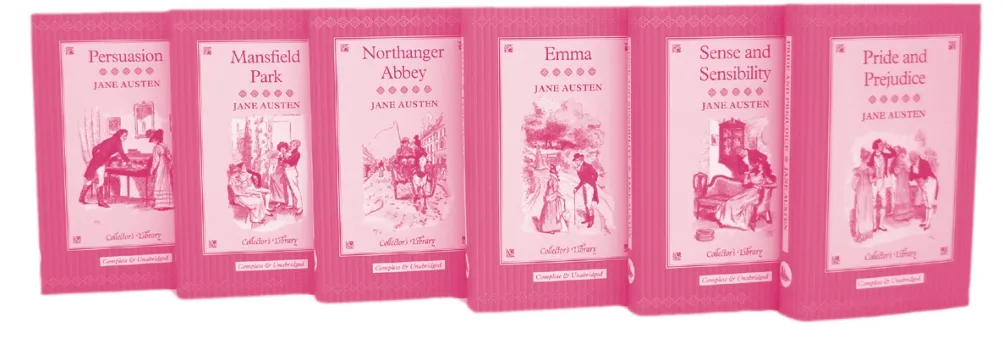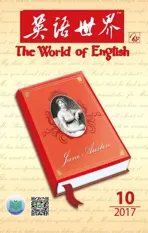Becoming Jane: How Austen Transformed into a Chick Lit1 Icon
2018-01-04By
By
Becoming Jane: How Austen Transformed into a Chick Lit1Icon
ByClaire Fallon
On the 2013 “Austenland” movie poster, Jane (Keri Russell) holds up a tote bag2tote bag容量较大的单肩包。that reads “I ❤ Mr. Darcy.”
[2] Two hundred years after her untimely death, this is what we think of when we think of Jane Austen. Darcythemed T-shirts. Lizzie Bennet action figures. Colin Firth in a soaking-wet top. Lonely women who nurse visions of Regency elegance and old-fashioned courtship. Movies in which studly men profess undying love to beautiful women in the midst of astonishingly cinematic rainstorms.
[3] To those who have a passing familiarity with Austen, this, no doubt,makes perfect sense. In our cultural consciousness, the author stands for decorous, chaste courtship; rags-toriches romance; elegant ballgowns and gallant suitors who invite eligible maidens to dance rather than Net fl ix and chill3Netflix一家在线影片租赁提供商,成立于1997年,主要提供Netflix超大数量的DVD并免费递送,总部位于美国加利福尼亚州洛斯盖图。“Do you want to come to my house for Netflix and chill?”是当今年轻人找一夜情的常用语,字面意思是看看片子放松一下。作者意指现在男女约会以看网剧始,以交欢终。. She represents an escapist, sentimental fantasy structured around speci fi c female desires, which makes some passionately devoted to her and others disdainful.
[4] But to others―critics, scholars and many readers―this whole idea of Austen is wrong. This conception glosses over her pointed satire, which often critiqued the social sphere she depicted.It also ignores Austen’s own skepticism about unbridled romantic sentiment.
[5] How did we get here, to this state of simultaneous Austen-mania and Austen-disdain? How did Jane Austen become the Jane Austen we know today?
Jane, The Realist
[6] Austen may not have been the poster child for romance back when she began publishing her books, but scholars have noticed a bifurcation in her reader response from the very beginning: Some read her for a bit of escapism and love stories, and some enjoyed the complexity and wit of her narratives.
[7] Her books were viewed seriously by critics, who admired her observation of social and familial dynamics, her nimble prose and her psychologically complete characters. At the time, they were hardly on the frivolous end of the spectrum. “Historically, Austen’s books have not been viewed as ‘chick lit,’ that is, as novels occupied with subjects like marriage and love, subjects which are supposed to please and interest women,” said Karen Bloom Gevirtz, associate professor of English and co-director of the Women and Gender Studies Program at Seton Hall University.
[8] In a contemporaneous review ofEmma, a critic (speculated by scholars to have been Sir Walter Scott4(1771—1832),英国著名历史小说作家。) admiringly, and humorously, contrasts Austen’s work with the overwrought romances of most popular novels of the time, which typically starred a heroine who “was regularly exposed to being forcibly carried off like a Sabine5古代意大利中部的一个民族,公元前三世纪被罗马人征服。virgin by some frantic admirer” and rarely managed to evade “masked ruffians, an insidious ravisher, a cloak wrapped forcibly around her head, and a coach with the blinds up driving she could not conjecture whither.”Emma, on the other hand,keeps “close to common incidents, and to such characters as occupy the ordinary walks of life.” Austen, he gushes,“has produced sketches of such spirit and originality, that we never miss the excitation which depends upon a narra-tive of uncommon events.”
Jane, The Escapist
[9] Initially, Austen broke with novel-writing conventions by writing everyday stories rather than escapist ones. But something happened in between then and now: 200 years passed.The everyday life of the minor gentry in early 19th century England no longer seems like a commonplace setting to Austen’s readers―it’s become exotic through distance.
[10] But it’s not just the sepia-toned filter6一种色彩偏黄、有复古感觉的滤镜,置于镜头前以改善画面效果。作者意指现在人们通过影视作品了解奥斯丁的方式。through which we now see Austen novels that changes the way we interpret her stories. Though the author subverted conventions of the Gothic romances of her day, she didn’t exactly blow it up―she satirized it within the confines of a marriage plot narrative.“The novels certainly feature heroines who feel acutely and suffer (generally in silence) because of love,” pointed out Lynch. Amidst the satire, Austen also speaks in a “psychological idiom that makes us feel, almost as though as it were our own, the experience of melancholy or distressed heroines like Anne Elliot or Elinor Dashwood7《理智与情感》的两位女主人公。.”
[11] In short, Austen’s empathetic portrayals of women in love are just as powerful as her caustic wit. The entire plot of each book hinges on at least one potential love match, featuring well-developed, charming heroes and heroines,which makes it easy to engage with them on the level of a romance novel.The romantic angle of Austen is easier to pick up on, and to replicate, than her social commentary.
[12] “Austen’s social representation is actually quite hard to interpret,”explained Deidre Lynch, Ernest Bernbaum8美国学者,英语教育家,曾在哈佛大学任教。此处指学术荣誉。Professor of Literature at Harvard University. ” [S]he’s so subtle―and that subtlety leaves much room for disagreement.” The love stories, on the other hand, are pretty straightforward,not to mention less controversial. “Because it’s so easy to empty her work of its sharp social, political and economic criticism,” Gevirtz toldHuffPost, “an Austen adaptation can please a wide variety of viewers.”
Jane, The Hollywood Star
[13]Pride and Prejudice, in particular, slots neatly into a romantic comedy template that predated Austen. In comparison to hectic Gothic and sprawling Victorian novels, her relatively compact, universally appealing plots were perfect for fi lm adaptation.
[14] As these screen versions proliferate, film has increasingly become the mode through which people encounter Austen’s work. “Although adapting the novels as screen romances goes back at least to MGM9=Metro-Goldwyn-Mayer米高梅电影公司,曾为美国好莱坞八大影业公司之一。’s 1940 fi lm of ‘Pride and Prejudice,’ it’s become a particularly intense cultural practice since the mid-1990s,” said Gevirtz. Even the versions lauded as the most faithful, however,can’t replicate the experience of reading her novels―and essential aspects of her genius are easily lost in translation.
[15] The dialogical humor only comprises part of the biting, revealing comedy of the novels, which is often driven by Austen’s drily observant narrator―which is typically the fi rst thing to go in a fi lm version. “The narrator in particular can be difficult to establish with a camera,” noted Gevirtz, “and although some productions use voice-overs or particular filming techniques, it’s not the same.”
[16] The novels’ association with their generally sappy film adaptations has only fed Austen’s image as a purveyor of insubstantial chick lit. “While Austen’s novels are Great Books, the film adaptations are often seen by scholars as sentimental and frivolous,”writes scholar Pamela Demory. The result has been a shift in how we see Austen herself.
[17] For one thing, as the fi lms comprise an increasingly large part of our Austen diet, we begin to weave images and moods of the movies into our cultural idea of the books. Take one famous example: There’s no scene, in Austen’sPride and Prejudice, in which Mr. Darcy emerges, sopping wet, from a pond. Nor is there a scene in which he and Elizabeth encounter each other amid a rainstorm, drenched from head to toe. And yet, sexy-wet Darcy has become almost inextricable from canonical Darcy.
[18] Always an appealing romantic lead, handsome and warm-hearted despite his forbidding demeanor, his brooding depth and unquenchable passion have been drawn out in film adaptations. Darcy’s emergence as a delectable, crushworthy celebrity has positionedPride and Prejudiceas a wishfulfillment fantasy for straight women rather than a social commentary.
[19] Biopics of Austen herself have borrowed from the romantic plots of her books to craft a portrait of an author inspired and motivated by her own heartbreak. Gevirtz pointed to “Becoming Jane,” a 2007 Anne Hathaway fl ick,which suggests Austen suffered an early heartbreak which inspired the love story ofPride and Prejudice. “The trailer for[‘Becoming Jane’] urged, ‘Discover Jane Austen’s untold romance, that would become the inspiration for her greatest love stories,’” said Gevirtz.“The facts of Austen’s life, however, do not support a narrative of a romantically-disappointed Jane endlessly seeking solace by compulsively rewriting her ruined romance with a happy ending.”Rather, there’s plenty of evidence that she was a gifted and dedicated artist who honed her craft for many years,beginning in her youth. By recasting the author as a lovelorn woman dwelling on her own loss, argues Gevirtz, we allow the novels to be “reduced to love stories and nothing but love stories.”

Jane Contains Multitudes
[20] The relentless churn of Austen adaptations, which increasingly allude to each other rather than the original work, has spawned a new idea of the author and her fans, a smaller understanding of her novels that has grown big enough to overshadow their real complexities. When we defend Austen by saying she’s more than that, we risk reinforcing the idea that chick lit is dumb; when we defend her by saying chick lit is worthwhile, we risk rein-forcing the idea that her work fi ts neatly into the genre rather than acknowledging her unique genius.
[21] But both are true, and Austen is worth defending on both fronts. Austen’s deftly handled marriage plots offer a relatively empowering path through a patriarchal realm that continues to resonate today: a marital partnership based on mutual love and respect. It makes sense that this Austen was a forerunner to a chick fl ick genre in which women and their desires take center stage.Much of the delicate irony and layered social commentary, however, don’t make it to the screen alongside the love stories―and this precise, observant wit is what originally elevated her work above other marriage plot novels of the time.
[22] Two hundred years after her death, it feels only right to celebrate both Austen’s cultural ascendancy,which continues to balloon, and the genius of her novels, which hasn’t changed or diminished in two centuries.Her loyal fans tend to struggle with embracing all of these aspects―the schmaltz and the satire, the lowbrow and the highbrow. Her readers’ passionate sense of ownership, and the multiplicity of ways in which we read her work, might be the most profound possible testament to her art’s enduring power.
在2013年上映的《奥斯丁庄园》的电影海报上,简(凯丽·拉瑟尔饰)手拿一个托特包,上面写着“我❤达西先生”。
[2]在奥斯丁过早离世200年之后,缅怀斯人,斯人如斯。达西主题的T恤衫。莉齐·贝内特人偶。身着湿漉漉上衣的科林·费斯。向往摄政时期的优雅和老式求婚的单身女子。描述健硕男子在骇人暴雨中向丽人倾诉永恒爱情的电影。
[3]无疑,对那些一时兴起而了解奥斯丁的人来说,这完全可以理解。在我们的文化意识中,作者奥斯丁代表的是正统、纯洁的恋爱,是乞丐变富翁的浪漫故事,是优雅的晚礼服,是殷勤求婚者邀请中意的少女跳舞而不是找一夜情。她代表避世者,围绕特定的女性欲望构筑的情感故事,这使一些人狂热忠实于她,而另一些人则对她嗤之以鼻。
[4]然而,对另一些人,即批评家、学者和许多读者来讲,对奥斯丁的这些看法全都错了。这些看法掩盖了她对自己所描写的社交圈常有的尖锐讽刺,也忽略了奥斯丁本人对于不加克制的浪漫感情的怀疑。
[5]那么我们怎么理解奥斯丁热和厌恶奥斯丁这同时存在的两种情绪呢?过去的简·奥斯丁是怎样成为今天我们心目中的奥斯丁的?
现实主义者——简
[6]在奥斯丁小说出版之初,她也许并非浪漫故事的代言人,但是学者们一开始就从读者反应中,注意到了态度的分歧:一些人将其作品当作逃避现实的一种方式或当作爱情故事来阅读,还有一些人喜欢复杂的小说情节和其睿智的叙事才能。
[7]批评家们严肃看待她的小说。他们欣赏其对社会和家庭动态的观察、灵活的行文及其对人物所作的全方位心理描写。那时,他们并不关心小情小爱的情感故事。西顿大学英语副教授兼妇女与性属研究项目联合主任卡伦·布卢姆·格沃茨说:“以前,奥斯丁的小说一直未被视为‘少女文学’。少女文学就是指以婚姻和爱情为主题并以此取悦和吸引女性的文学。”
[8]在《爱玛》一书同时代的书评中,一个批评家(学者们推测应该是沃尔特·斯科特爵士)抱着欣赏的态度十分幽默地将奥斯丁的作品和当时最受欢迎的一些浪漫故事做了对比。那些故事情节过度紧张,女主角通常“像一个萨宾少女,被某个狂热的追求者强行抬走”,很少能够逃脱“蒙面的恶棍,阴险的强奸犯。她的头上被强行遮着斗篷,还有窗帘卷起的四轮马车,不知会去到何处” 。相反,《爱玛》的故事“近似于平常之事,与普通的各行各业的人物很接近”。他夸张地赞赏说,奥斯丁“作品呈现出的精神和独创性,总是让我们激动不已,这种激动源于她对非寻常之事的描绘”。
避世者——简
[9]一开始,奥斯丁一反小说写作传统,记述日常琐事而非避开现实。然而从那时至今,200年过去了,对奥斯丁的读者们来说,19世纪早期英国未成年贵族的日常生活不再是普通的小说背景,它因年代久远而变得新奇。
[10]然而,并不只是我们现在用以欣赏奥斯丁小说的棕色滤镜会改变我们对其故事的解读。奥斯丁尽管颠覆但并未摧毁那个时代的哥特小说传统。她在有关婚姻情节的叙事中对当时的传统冷嘲热讽。“小说的女主人公常常性格敏感,(通常是默默地)被爱所伤。”林奇指出。在冷嘲热讽中,奥斯丁还会以一种“我们几乎感同身受的心理风格叙述,让我们去体会安妮·艾略特或埃莉诺·达什伍德等女主人公的忧郁哀伤或烦恼。”
[11]简言之,奥斯丁对恋爱中女性善解人意的描写和她的尖锐刻薄所体现的机智一样有力。每本小说的整体情节都至少聚焦于一个可能发生的自>由恋爱,男女主角皆性格成熟,魅力十足,这些特点使得他们很容易成为爱情小说的主线联系。相比奥斯丁对社会的评论,其爱情视角更容易让人领悟和模仿。
[12]“实际上奥斯丁对当时社会状态的再现让人难以解读。”哈佛大学欧内斯特·伯恩鲍姆文学教授戴德丽·林奇解释说,“她太含蓄了,含蓄得让人大可产生有异于她所表达的解读。”从另一方面来说,爱情故事相当直白,不用说也更少争议。格沃茨告诉《赫芬顿邮报》说:“因为很容易删除作品中对社会、政治和经济的尖锐批评,所以改编的奥斯丁作品能够取悦很多趣味各异的观众。”
好莱坞明星——简
[13]《傲慢与偏见》特意将情节巧妙装入早在奥斯丁创作之前就已经存在的浪漫喜剧模式。与焦躁不安的哥特小说及枝节繁多的维多利亚小说相比,她的小说相对紧凑,情节动人,不分国界,是改编电影的绝佳素材。
[14]随着奥斯丁作品越来越多地出现在银屏上,电影愈加成为人们邂逅奥斯丁作品的方式。格沃茨说:“虽然将小说改编为电影故事至少可追溯至1940年米高梅公司拍摄的《傲慢与偏见》,但自90年代中期以来,这种做法已成为人们争相进行的文化活动。”即使那些被赞为最忠实于小说的改编,也无法与阅读小说的体验完全一致——另外,作品中显示其天赋的重要方面也很容易在改编中丢失殆尽。
[15]小说中最具讽刺、最有说服力的喜剧效果只有部分来自幽默的对话,这通常是由奥斯丁笔下不动声色又善于观察的叙事者来推动的,而叙事者总是改编电影第一个被消除的元素。格沃茨说:“用镜头来塑造叙事者可能尤其困难。虽然有些影片采用画外音或其他特殊的拍摄技巧,但还是不一样。”
[16]通常,电影将小说改编得十分多愁善感,结果强化了这种认知,即奥斯丁只会写毫无营养的少女文学。学者帕梅拉·德莫里写道:“在学者们看来,如果说奥斯丁的小说是伟大的作品,电影改编则多为多愁善感而无甚价值。”结果却导致我们看待奥斯丁本人的方式发生了变化。
[17]首先,对于我们所了解的奥斯丁,电影提供了越来越多的素材。所以我们开始把电影中的形象和情绪植入我们对小说的文化认知中。一个众所周知的例子是:在奥斯丁的小说《傲慢与偏见》中,并没有达西先生湿漉漉地从池塘爬出来的一幕,也没有他和伊丽莎白在暴风雨中邂逅被雨水淋透的场景。然而,湿身性感的达西和经典达西几乎已融为一体。
[18]尽管他态度冷峻,但仍是帅气、热心、浪漫的榜样,让人怦然心动。而电影并未表现出他深邃的思想和难以克制的爱情。电影版达西,一个让人喜爱、值得为之倾心的名人,已使《傲慢与偏见》成为直女们愿望实现的幻想故事,书中的社会批评被大大忽略。
[19]奥斯丁的传记电影借用小说中的浪漫情节,塑造了一个为情所伤并因此迸发出创作动力的作者形象。格沃茨指的是2007年由安妮·海瑟薇出演的电影《成为简·奥斯丁》。影片暗示,奥斯丁早年为情所困而写下爱情故事《傲慢与偏见》。“《成为简·奥斯丁》的预告片鼓动道:‘揭秘简·奥斯丁不为人知的罗曼史,其笔下最伟大爱情故事的灵感来源’。”格沃茨说,“可是,从奥斯丁本人的生平故事来看,没有迹象表明,情场失意的她通过给失败的恋情硬生生写出幸福结局来不断寻求慰藉。”非但如此,大量证据表明,奥斯丁是个全心投入的天才作家,自年轻时起,多年来一直在锤炼自己的写作技巧。格沃茨表示,将奥斯丁重塑为深陷失恋之痛的妇女,我们不过是任由伟大的小说“降格为爱情故事,单纯的爱情故事”。
多面体——简
[20]奥斯丁作品改编不断出现,这些作品并非借鉴原著,而是越来越多地互相借鉴,这使人们对奥斯丁及其粉丝产生了新的看法。这些改编作品对其小说的理解更加狭隘,而这样的理解得到越来越广泛的接受,已导致小说本身的丰富性被遮蔽。当我们说奥斯丁作品的意义远不止于此并以此来捍卫她时,我们是在冒险强化这种观点,即少女文学是愚蠢的;当我们说少女文学值得欣赏并以此来捍卫她时,我们又是在冒险忽略她独特的天赋而强化这种观点,即奥斯丁的作品只能归入少女文学。
[21]但是上面提到的两种情况都是事实。在这两个方面,奥斯丁都是值得我们捍卫的。奥斯丁对婚姻情节的精湛处理,为直至今日父权之声依然回荡的世界指出了一条颇为有力的途径:婚姻是建立在互尊互爱基础上的合伙人制。这样的奥斯丁将女性及其欲望作为作品焦点,是言情片这一体裁的先驱者,这是很有意义的。然而,其作品中许多精妙的讽刺以及不同层次的社会批评,并未与爱情故事一起在屏幕上呈现——而原本正是作品中这些精确、洞见的智慧,使其作品的成就高于当时以婚姻为主题的其他作品。
[22]奥斯丁辞世200年之后,人们确实应该纪念她,既因其作品的文化优势依然在扩大,也因其小说呈现的天赋两个世纪后依然没有改变或减少。她的忠实粉丝在面对作品中的伤感和讽刺、媚俗和高雅时,往往会纠结不已。读者所感受到的浓浓的归属感以及对其作品的多种解读,也许就是奥斯丁经久不衰的艺术魅力最深远、最切实的证明。
奥斯丁何以变身少女文学偶像
文/克莱尔·法伦译/凯希
1 chick lit小妞文学(旨在迎合女性口味、主角常为单身少女的小说)。
